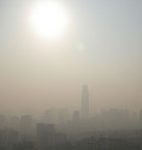The news late last month from China’s environment ministry that it plans to bring one of the country’s most destructive and widespread pollutants – tiny particulates widely known as PM 2.5 – into national air quality standards suggests that attitudes to pollutant data, once deemed too politically sensitive to gather, may be shifting.
Air particulates with a diameter of 2.5 microns or less (hence “PM 2.5”) have serious health implications. Small enough to penetrate human lung tissue, they can cause asthma, lung cancer and cardiovascular disease. In most parts of China, PM 2.5 has been found to account for more than half of air particulate pollution. But despite these serious pollution levels and impacts, national air-quality standards in China have lacked requirements for monitoring PM 2.5, or specific reduction targets – until now.
Speaking at Seventh Environment and Development Forum on September 22, China’s pollution control secretary Zhao Hualin announced that the Ministry of Environmental Protection (MEP) intends to revise its national ambient air quality standards to include PM 2.5 measurements. Recognising the contribution of PM 2.5 pollution to poor visibility and air quality, Zhao told the audience, “We have now started to address the haze problem, which is precisely a PM 2.5 problem”.
The idea is for China’s so-called “model cities” to pilot particulate measurement, themselves something of a shifting phenomenon. In late August, the MEP made revisions for the second time as to what criteria are necessary to qualify as a National Environmental Protection Model City – a title given to cities to reward special efforts in the green sphere – and PM 2.5 measurement is among the requirements.
Under these new standards, only 11 cities now qualify as model cities, vastly fewer than the 77 reported to have carried the title before the changes. They are: Wujiang, Liaocheng, Qingpu District of Shanghai, Linyi, Dongguan, Xuzhou, Yinchuan, Yichang, Linan, Huai’an and Foshan. Three more have undergone review and are in the process of being designated as model cities, while the remaining locations previously considered model cities are under review.
The strengthening of air quality metrics suggests that the political tides surrounding pollutant data may be changing. When the MEP released draft amendments to its Air Pollution Index (API) in late February of this year, the inclusion of PM 2.5 was notably absent, despite the addition of ozone and a number of other considerable improvements.
The omission was criticised as a political maneouvre rather than a decision stemming from a lack of technical capacity in Chinese cities to measure the pollutant. Ma Jun, who directs the Beijing-based Institute of Public and Environmental Affairs, told the Global Times, “Government agencies feel the [inclusion of PM 2.5 in the] index may hurt the image of many cities that want to attract investment or that they may not be able to improve PM 2.5 pollution in a short time.”
Secret US diplomatic cables, released by Wikileaks, further corroborated such suspicions, reporting research by local scientists that revealed PM 2.5 levels five to 10 times higher than World Health Organisation guidelines was deemed “too sensitive” for authorities and therefore not systematically measured in major Chinese cities. But just months after the release of draft API revisions and the diplomatic cables, secretary Zhao has claimed that measurement of PM 2.5 is “technically no longer a problem”. So, how big a step is this?
The first thing to make clear is that Zhao was most likely referring to the question of technical capability to measure PM 2.5, and questions remain as to whether political sensitivities around environmental data still exist. The memory of a failed attempt to quantify economic losses attributable to environmental harms is still fresh in the MEP’s memory. In 2007, the conclusions of China’s “Green GDP” project met stiff resistance from provincial leaders who feared yet another performance metric, and the results of the report were never officially released. The then-State Environmental Protection Agency and National Bureau of Statistics were left quibbling over data and methodology – a testament to how contentious attributing numbers to pollution can be.
However, recent signs that China is embracing a more transparent approach to its environmental challenges are evident. In early June, the MEP released a franker assessment of China’s environment than seen previously in the latest annual State of the Environment Report. Vice-minister Li Ganjie stated that while some aspects of the environment showed modest improvement, “the overall environmental situation is still very grave and is facing many difficulties and challenges”. Only 3.6% of the 471 cities monitored in the most recent report garnered top ratings for clean air.
Deborah Seligsohn, principal advisor to the World Resources Institute’s Climate and Energy Program, has also noted a dramatic shift in language since the 1990s when the annual reports claimed that China’s environmental situation was “basically good” or, later, “basically unchanged”. Not until the State Environmental Protection Agency achieved ministerial status in 2007 did the reports become more critical, describing the environment as “not inspiring”.
Including the politically sensitive PM 2.5 in air-quality standards signals a push for greater transparency in China’s environmental governance. Over the course of a few months the MEP has already taken significant strides to improve air quality measurements and standards. This will bring China’s policies closer to international best practices for air quality monitoring.
Piloting measurement in model cities makes political sense as a way of easing China into eventual binding PM 2.5 targets for all provinces – a mandate that will likely be included in the 13th Five-Year Plan. By first signaling that PM 2.5 is an aspiration for “model cities”, the government is taking an important step toward lessening political stigma surrounding the pollutant: instead of being punished, cities will be rewarded.
PM 2.5’s inclusion is also indicative of a broader trend: China’s transition to a political culture that is more open about environmental conditions. Importantly, if it continues, this openness will allow greater public access to data and information, in turn spurring better results for the environment.
Angel Hsu is a doctoral student at the Yale School of Forestry and Environmental Studies and project director for the 2012 Environmental Performance Index.
Homepage image by Helga’s Lobster Stew




